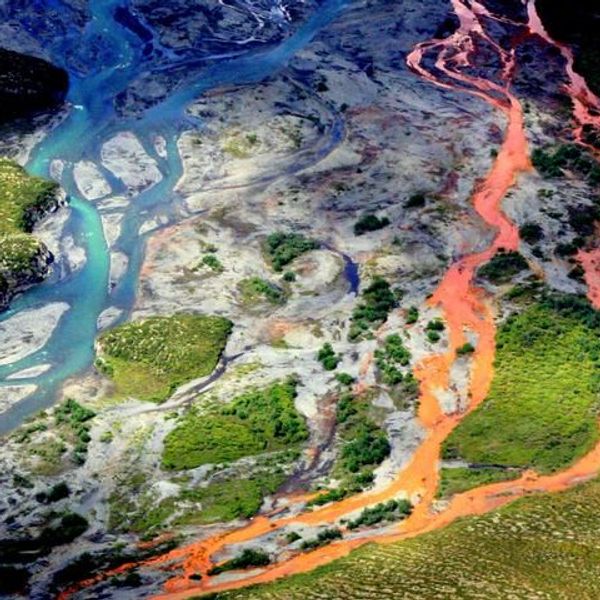Smashing All Previous Records, 2015 on Track to Be Hottest Year Yet
...and 2016 may likely be even hotter, scientists warn
The planet Earth, with mankind's help, is leap-frogging into sweltering new territory.
With the monthly update from the National Oceanic and Atmospheric Administration (NOAA) out Monday, three of the world's official climate reporting agencies agree that June 2015 was the hottest on record and that this year is shaping up to be the hottest year yet.
Moreover, scientists say this trend is likely to continue, and that 2016 could surpass 2015's record-breaking temperatures.
According to NOAA, "The June globally-averaged land surface temperature was 2.27degF (1.26degC) above the 20th century average. This was the highest for June in the 1880-2015 record, surpassing the previous record set in 2012 by 0.11degF (0.06degC)."
This followed reports from NASA and the Japan Meteorological Agency last week, which found similar results. According to both NASA and NOAA, the year-to-date period (January-June) was also the warmest such period on record, with four of the six warmest months in recorded history occurring so far in 2015, putting us on the path to breaking 2014's record as the hottest documented year.
As journalist Andrew Freeman notes, "The heat in 2015 isn't just breaking records, it's smashing them."
Scientists attribute this heat to human-induced global warming and a particularly potent El Nino event, which meteorologist Dr. Jeff Masters says "continues to intensify."
"This extra bump in temperature, when combined with the long-term warming of the planet due to human-caused emissions of heat-trapping gases like carbon dioxide, makes it likely that 2015 will be Earth's second consecutive warmest year on record," Masters wrote on his Wunderground blog on Monday.
Deke Arndt, chief of the monitoring branch of NOAA's National Centers for Environmental Information (NCEI), explained recently how climate change interacts with an El Nino weather pattern to drive overall temperature increases.
"Climate change is a long-term driver, so that's like standing on an escalator as it goes up," Arndt said during a press conference call last month. Alternately, El Nino "is like jumping up and down while you're on that escalator."
"So, the longer that we go into history, we're riding up the escalator. And now that we're getting an El Nino event, we happen to be jumping up at the same time, and so they play together to produce outcomes like what is likely to be the warmest year on record," Arndt said.
Further, citing data from the International Research Institute (IRI) for Climate & Society, ThinkProgress notes a more than 85 percent chance that this current El Nino may last until May 2016, with the strongest period being December through February.
"If this pattern plays out, then 2016 would likely top whatever temperature record 2015 sets -- again, possibly by a wide margin," ThinkProgress reports.

An Urgent Message From Our Co-Founder
Dear Common Dreams reader, The U.S. is on a fast track to authoritarianism like nothing I've ever seen. Meanwhile, corporate news outlets are utterly capitulating to Trump, twisting their coverage to avoid drawing his ire while lining up to stuff cash in his pockets. That's why I believe that Common Dreams is doing the best and most consequential reporting that we've ever done. Our small but mighty team is a progressive reporting powerhouse, covering the news every day that the corporate media never will. Our mission has always been simple: To inform. To inspire. And to ignite change for the common good. Now here's the key piece that I want all our readers to understand: None of this would be possible without your financial support. That's not just some fundraising cliche. It's the absolute and literal truth. We don't accept corporate advertising and never will. We don't have a paywall because we don't think people should be blocked from critical news based on their ability to pay. Everything we do is funded by the donations of readers like you. Will you donate now to help power the nonprofit, independent reporting of Common Dreams? Thank you for being a vital member of our community. Together, we can keep independent journalism alive when it’s needed most. - Craig Brown, Co-founder |
The planet Earth, with mankind's help, is leap-frogging into sweltering new territory.
With the monthly update from the National Oceanic and Atmospheric Administration (NOAA) out Monday, three of the world's official climate reporting agencies agree that June 2015 was the hottest on record and that this year is shaping up to be the hottest year yet.
Moreover, scientists say this trend is likely to continue, and that 2016 could surpass 2015's record-breaking temperatures.
According to NOAA, "The June globally-averaged land surface temperature was 2.27degF (1.26degC) above the 20th century average. This was the highest for June in the 1880-2015 record, surpassing the previous record set in 2012 by 0.11degF (0.06degC)."
This followed reports from NASA and the Japan Meteorological Agency last week, which found similar results. According to both NASA and NOAA, the year-to-date period (January-June) was also the warmest such period on record, with four of the six warmest months in recorded history occurring so far in 2015, putting us on the path to breaking 2014's record as the hottest documented year.
As journalist Andrew Freeman notes, "The heat in 2015 isn't just breaking records, it's smashing them."
Scientists attribute this heat to human-induced global warming and a particularly potent El Nino event, which meteorologist Dr. Jeff Masters says "continues to intensify."
"This extra bump in temperature, when combined with the long-term warming of the planet due to human-caused emissions of heat-trapping gases like carbon dioxide, makes it likely that 2015 will be Earth's second consecutive warmest year on record," Masters wrote on his Wunderground blog on Monday.
Deke Arndt, chief of the monitoring branch of NOAA's National Centers for Environmental Information (NCEI), explained recently how climate change interacts with an El Nino weather pattern to drive overall temperature increases.
"Climate change is a long-term driver, so that's like standing on an escalator as it goes up," Arndt said during a press conference call last month. Alternately, El Nino "is like jumping up and down while you're on that escalator."
"So, the longer that we go into history, we're riding up the escalator. And now that we're getting an El Nino event, we happen to be jumping up at the same time, and so they play together to produce outcomes like what is likely to be the warmest year on record," Arndt said.
Further, citing data from the International Research Institute (IRI) for Climate & Society, ThinkProgress notes a more than 85 percent chance that this current El Nino may last until May 2016, with the strongest period being December through February.
"If this pattern plays out, then 2016 would likely top whatever temperature record 2015 sets -- again, possibly by a wide margin," ThinkProgress reports.

The planet Earth, with mankind's help, is leap-frogging into sweltering new territory.
With the monthly update from the National Oceanic and Atmospheric Administration (NOAA) out Monday, three of the world's official climate reporting agencies agree that June 2015 was the hottest on record and that this year is shaping up to be the hottest year yet.
Moreover, scientists say this trend is likely to continue, and that 2016 could surpass 2015's record-breaking temperatures.
According to NOAA, "The June globally-averaged land surface temperature was 2.27degF (1.26degC) above the 20th century average. This was the highest for June in the 1880-2015 record, surpassing the previous record set in 2012 by 0.11degF (0.06degC)."
This followed reports from NASA and the Japan Meteorological Agency last week, which found similar results. According to both NASA and NOAA, the year-to-date period (January-June) was also the warmest such period on record, with four of the six warmest months in recorded history occurring so far in 2015, putting us on the path to breaking 2014's record as the hottest documented year.
As journalist Andrew Freeman notes, "The heat in 2015 isn't just breaking records, it's smashing them."
Scientists attribute this heat to human-induced global warming and a particularly potent El Nino event, which meteorologist Dr. Jeff Masters says "continues to intensify."
"This extra bump in temperature, when combined with the long-term warming of the planet due to human-caused emissions of heat-trapping gases like carbon dioxide, makes it likely that 2015 will be Earth's second consecutive warmest year on record," Masters wrote on his Wunderground blog on Monday.
Deke Arndt, chief of the monitoring branch of NOAA's National Centers for Environmental Information (NCEI), explained recently how climate change interacts with an El Nino weather pattern to drive overall temperature increases.
"Climate change is a long-term driver, so that's like standing on an escalator as it goes up," Arndt said during a press conference call last month. Alternately, El Nino "is like jumping up and down while you're on that escalator."
"So, the longer that we go into history, we're riding up the escalator. And now that we're getting an El Nino event, we happen to be jumping up at the same time, and so they play together to produce outcomes like what is likely to be the warmest year on record," Arndt said.
Further, citing data from the International Research Institute (IRI) for Climate & Society, ThinkProgress notes a more than 85 percent chance that this current El Nino may last until May 2016, with the strongest period being December through February.
"If this pattern plays out, then 2016 would likely top whatever temperature record 2015 sets -- again, possibly by a wide margin," ThinkProgress reports.


